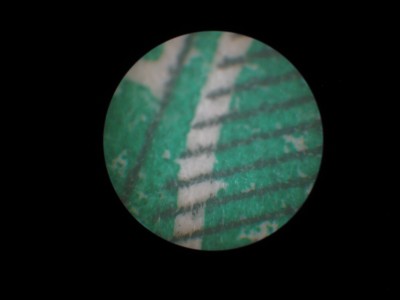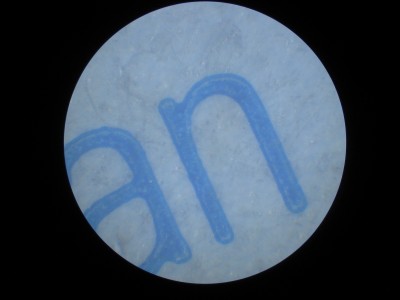Slides and coverslips are back ordered, so I am still playing with stuff I can front illuminate. For your viewing pleasure, ordinary table salt, magnified 70x.
Monthly Archives: May 2010
From my home office: first picture through my microscope
As you might have guessed, I’m a “collector”. Not of anything in particular, but of anything that interests me even vaguely. A few years ago, I bought an old Zeiss Jena laboratory microscope at a swap meet for (if memory serves) around $50. It’s a very nice, heavy microscope and included a pair of Zeiss eyepieces (7x and 10x) and a pair of objectives (10x and 40x). I hadn’t done much with it, but recently I’ve begun to think of fun things that I might do with it, so I dusted it off. Of course, to share pictures of what I see, I’d need to be able to take a photograph through it, so the first order of the day would be to see what I could do with my little Canon SD1100 (a small point-and-shoot camera). Since I didn’t have any microscope slides, I just clamped a dollar bill onto the stage. I installed the 10x objective with a 7x eyepiece, roughly aimed an led flashlight at the mirror, and clicked this picture:
Not bad at all. The image isn’t very well focused because, well, it isn’t very well focused, and because the dollar wasn’t clamped flat, so bits of it are in focus and out of focus, but it’s very promising. I need to setup a good light source and get some slides. Stay tuned, I have something in mind.
Addendum: I found a plastic container that had some small writing on it, which was a tiny bit flatter and setup my camera. I tried zooming in to get rid of the round vignette around the image, and shot these two pictures. Looks like this will work just great. I need to mock up a little mount to hold the camera, and work on getting a better light source, and then some slides and cover slips (already on order) and then… some slightly more interesting pictures hopefully.
From the code cellar: a program to find haiku in text…
While I was surfing around this weekend, I was reminded of the old sweetcode.org website (sadly, which is no more, but you can still see courtesy of the Internet Wayback machine if you like) and found an old chunk of code that I had archived that was written by Danny O’Brien based upon an idea by Don Marti. It basically would scan a text, break it into syllables, and then output any haikus (segments of text that have the 5-7-5 syllable counts). The program further allows you to specify that the haiku should start with a capital letter, and end with a period.
It was a bit broken, but a few minutes of hacking got it working again, and I fed it one of my favorites: The Adventures of Sherlock Holmes. Here is a smattering of some of the better ones it found.
He never spoke of
the softer passions, save with
a gibe and a sneer.
You understand? I
am to be neutral? To
do nothing whatever.
She knows that the King
is capable of having
her waylaid and searched.
But then, when I found
how I had betrayed myself
I began to think.
Some letters get more
worn than others, and some wear
only on one side.
I can stand this strain
no longer; I shall go mad
if it continues.
Twice he struck at the
chamber door without any
reply from within.
He put out his hand
and coldly grasped that which she
extended to him.
It is all dark to
me. But perhaps it may grow
lighter as we go.
I’m not sure why I find these so amusing.
Maidenhead Grid, courtesy of geolocation in HTML5
If you are using Firefox, the accuracy might be good, or might be bad. It really depends on how effective Google’s IP based geolocation is in your area. At my brother’s house in Hillsboro, OR (near the Intel Campus) it was very, very accurate. Of course, if you are using the iPhone, it uses the built-in GPS. Feel free to swipe this idea and use it however you see fit.
If you find this useful, please let me know, and I’ll consider making a more permanent home for it. I’d also welcome any other suggestions on things that might make it more useful.
Addendum: I made some improvements (notably, to also give the accuracy of the measurement, and added a small google maps display) and IRC #hamradio buddy autojack confirmed that it works on his Android phone, and thoughtfully provided a couple of screenshots.
Martin Gardner, 1914 – 2010
Today, someone who had a big influence on my life (and whom I’ve never met) passed away: legendary recreational mathematician Martin Gardner. I learned about it from Phil Plait, of the Bad Astronomy blog, courtesy of his twitter feed. Phil writes up his own thoughts here:
Martin Gardner, 1914 – 2010 | Bad Astronomy | Discover Magazine.
I was first exposed to Gardner’s writings in Mathematical Games when I was still in grade school. Our local library used to give away books that they no longer wished in their collection, and at one point, they discarded a couple of decades worth of Scientific American. As a voracious reader of science, I carted dozens of issues home in my book bags over the span of a few days. While I had a wide variety of interests, I read two columns out of nearly every issue: C. L. Stong’s Amateur Scientist and Gardner’s Mathematical Games.
Others will cite Gardner’s greatest contributions as a skeptic, but the lasting impact that he has on me is conveying the mystery, the magic, and the fun of mathematics. It was through his pages that I first learned of John Conway’s “Game of Life” and cellular automata. Of the game Hex. Of Penrose tilings. Of public key cryptography. Of polyominoes. Of game theory. Flexagons. Polygonal dissections. Of machine learning. And dozens of puzzles that intrigued me for hundreds of hours.
I have eight or nine of his books, and still enjoy perusing them for puzzles I haven’t attacked before. His columns were often on cutting edge bits of mathematics, but neither tried to pander to the lowest common denominator, nor to be accessible to only a small mathematical priesthood: his work was accessible and challenging. He basically created recreational mathematics.
It’s hard to overemphasize that importance that the joy and exuberance that he brought to mathematics had on my life, and I’ve met dozens of others with similar stories.
Thanks for all your contributions Martin.
“He was a man, take him for all in all, I shall not look upon his like again.”
Hamlet — Act 1, Scene 2
Musings on Blogging and Social Media
Over the last couple of days, weeks, and even months, I’ve been pondering my participation in various social media: mostly my efforts at blogging and podcasting, but also my participation in things like Facebook and Twitter, as well as the possibility of using things like YouTube. I thought I’d toss out some ideas and ask for some feedback, so if any of this resonates with any of you out there, please feel free to comment.
My first posting on the brainwagon blog occurred on July 21, 2002. Since then I have posted 3,418 posts about a wide variety of topics. I’ve viewed this blog as an outlet for some of my geekier interests: if you look through it, you’ll see some trends which ebbed and flowed: podcasting, programming (especially my Atari 2600 and checkers), mathematics, and of course my recent fascination with ham radio. You’ll also see a scattering of just links to blogs and news items that I found enjoyable. I made two conscious decisions: I wouldn’t monetize my blog with advertising, nor would I seek to become a “pundit”, a talking head whose job it is to render opinions from on high about what people should or should not be doing or thinking.
I’m mostly pretty happy with those basics, except for one thing: I don’t feel like I’ve helped develop a community of people who are interested in doing the same. My blog, as interesting as the subjects appear to be to me, doesn’t seem to be very inspiring to others, at least as far as I can judge based on comment and email feedback. (Yes, there has been some positive feedback, but not as much as I would like.)
I’m faced with two conclusions.
One is that I’m interested in stuff that nobody else is interested in. That’s certainly a possibility, a very strong possibility. But when I go to places like the Maker’s Faire, or even interact with some of my fellow geeks at work, it seems that there are people out there who are interested. If I extrapolate that to the entire country, there really must be thousands of people who are potentially interested in the kinds of things that I’m interested in. Heck, I found a website for a guy who is interested in two of my more eclectic interests (Egyptian hieroglyphics and checkers, of all things) so you people must be out there.
So, I’m left with my other conclusion: that I’m not reaching other people in a fashion which inspires them to respond and engage. I think that there are several possible reasons for that. I think there are basic questions about technology: am I doing all I can to maximize the effectiveness of what presence I do have on the web? Would more use of Facebook/Twitter be helpful? Or maybe YouTube/Vimeo/iTunes podcasting? Or is there room for a new kind of social media that works to generate the kind of community vision that I crave?
But frankly, I think the problem is more basic than that.
I’m basically one of those people who is mostly happy living inside my head. I have recognized and even relished in the idea that what I like is relatively rare and geeky, so I haven’t done a lot of work to actually build the real social bonds that connect me to other people who share my visions and interests. Thus, the problem isn’t at the root a technological one: it’s likely a problem of my own personality and behavior.
While I think that making any significant changes to my personality is probably out of the question, i do think that there are changes to my online behavior which could be achieved. Just as I am trying to convince myself that frequent exercise is good for me, I can try to “exercise” my own efforts in building social bonds based upon mutual interest and vision.
The other thing is to try to simply do more inspiring stuff, and figure out more dynamic ways to share it. Many of my software projects are still in the “not-ready-for-release” stage, but that’s kind of cowardly of me. If you read that I had developed some code that did something interesting, and that I’d release it someday, you’d be bored and uninspired. If however, I released it and let you play with it, that’s much more engaging. And if I showed how you could use it to do cool things (like, say, predict when the ISS is overhead and photograph it) that would be more inspiring. I should recognize that I have only a couple of minutes of your time at best to get you interested and thinking about the stuff I like, and that if I really want to get you on board, I’ll have to work harder at it. I guess that it boils down to a simple new thought:
Mark, expend some effort to engage your audience.
In conclusion, I’m interested in finding peers and mentors who have built the kind of online presence and community that I’m seeking. If you have a blog or podcast that you are proud of, or have used Facebook or Twitter to build an online community, or just have some reading on the subject that you have found useful, please drop me a note at brainwagon at gmail.com if you would be interested in talking to me about this kind of thing.
Thanks again.
Converting Microsoft Lifecam Cinema HD Webcam for Telescope Use
Before computers, my first love-affair with geekiness was an interest in telescopes and astronomy. For the past few years, I’ve slacked off considerably in my telescope making activities, but every once in a while I see something that piques my interest. Gary Honis has a fascinating webpage that details several conversions of digital SLR cameras and webcams into a form which allows them to be used for astrophotography. I found the following link to be particularly interesting for planetary photography, since the webcam is a reasonably high resolution and shoots at 30fps. For bright objects like the moon and planets, this means that you can capture moments of good seeing, and use them to generate nice pictures. Archived for future perusal:
Instructions for Converting Microsoft Lifecam Cinema HD Webcam for Telescope Use -by Gary Honis.
The camera is actually very reasonably priced (only $54.03 via Amazon).
The WebM Project : Welcome to the WebM Project
While I am surfing around, I discovered that Google made good on their promise to release the VP8 codec they obtained from their acquisition of On2 earlier this year as a royalty-free open alternative to other video codecs. This isn’t of much use right now to end users, but hopefully this will result in a more ubiquitous and portable web video standard.
Google Font API Test
Google has a new API that enables you to easily embed a selection of fonts into web pages. It seems to work!
Try googling for “Google Font API” for more information.
Or you could merely click this link.
Atlantis + ISS cross the Sun
How to layer/remix videos with free command line tools « The Broadcaster Project
I work on video and audio files fairly often using a variety of free tools. FFmpeg is particularly useful for modifying video, and this hints at some of the fun you can have when you combine it with ImageMagick.
How to layer/remix videos with free command line tools « The Broadcaster Project.
On G4ILO’s Scratching the SDR itch
I try to surf a lot of different ham radio blogs, mostly for inspiration about projects. My own life has been a bit hectic lately, and isn’t really likely to calm down until summer is well underway, but I am still reading. Today’s posting was inspired by a posting over on G4ILO’s blog:
G4ILO’s Blog: Scratching the SDR itch.
Surf on over and read, then come back. Please, come back.
I empathize with the opinions to a large degree, but overall I can’t help but think that it’s a very “doom-n-gloom” viewpoint that requires some criticism to put it in perspective.
First of all, I think it’s important to understand that for at least the last twenty years, computers and software has been a part of radio. Sure, mostly they have just monitored buttons and updated displays, but increasingly they provide sophisticated filtering and signal processing that would be difficult, costly or simply impossible to provide any other way. Software-defined radios are merely the next logical step in a continuum of software design in radio. And just like we aren’t going back to spark or tubes, we are aren’t going back to radios without microprocessors in them: they are just too cheap and too useful.
When Julian says that “general purpose computers are just too much hassle”, he’s probably right, but that isn’t an indictment of software defined radio so much as a indictment of the means by which we currently consume it: namely by using an operating system which wasn’t very well designed for the purpose that we have co-opted it for. Let’s face it: 99% of the annoyance of current SDR stuff is related to sound card issues, and that’s mostly because Windows (doesn’t matter what version) basically sucks for sound handling. Each card implements a different set of controls which can’t be reliably configured for a dedicated application.
But there is more than just sound cards: Windows isn’t very well suited to the creation of interactive interfaces. Yes, using drop downs and mouse is annoying compared to just turning knobs. But that’s not to say that better interfaces can’t exist. And, in fact, there is considerable reason to believe that once you involve software, better interfaces can exist. Being able to display 200khz or more of spectrum, and select individual signals just by pointing is a blast. Being able to design bandpass or notch filters by drawing or adjusting the filter responses interactively is great. Being able to configure soft buttons to switch settings for different monitoring tasks is cool.
Lastly, when Julian says “With real radios you can look at the schematic and get in there with your soldering iron and make modifications and or fix faults”, but that somehow that isn’t possible with SDR, it’s mainly a matter of perspective. Modifying software isn’t particularly any more difficult than modifying hardware: in fact, the nice thing about software is that it is usually easier and less expensive to distribute your changes. Understanding how to use an FFT or frequency shift and filter signals isn’t really that much harder to understand than (say) the details of how a Gilbert Cell mixer works. It’s just a different set of skills, one that we can nurture or not as we see fit.
I want to see more rigs which provide generic USB interfaces for sound and serial control (or if you need the bandwidth, how ’bout gigabit ethernet?). I’d love to have a radio with all the normal front end, but when I plug it into my computer, wide band sound data is available via USB and a serial tty port becomes available on my Windows, Mac OS or Linux box. It’s totally doable, and would allow us the best of both worlds.
I have an SDR-IQ, and it’s a nifty little gadget (although does require special driver support, which is a teensy bit annoying, although the drivers do exist on Windows and Linux). It literally is a black box, with a USB cable and an antenna port, and a single LED. It’s incredibly versatile, and one of the principle uses they have for them is to provide an wideband panadapter interface at the IF of conventional HF rigs. There is no reason that it has to be a separate box: it could be built into more conventional rigs.
I for one embrace our increasingly software defined future, and the new era of experimentation that it will bring. I think the real challenge will be to either acquire the necessary skills and imagination to create the applications that we all want, or to at least encourage a generation of younger software engineers to invest the time to do it.
Why I can’t play checkers very well…
White is to move. It isn’t that hard to find the move that draws, but in two minutes, I couldn’t work out the move that wins for White. All other moves are dead losses for White. Solving this puzzle requires basic visualization skills which seem beyond my current capabilities.
Milhouse of course immediately answers 27-23.
Addendum: I should have been able to sort this out. 22-18 obviously loses a checker. 22-17 is the obvious drawing move (although red has to respond with 7-11, responding with the slightly plausible looking 15-18 is a loss, but is fairly tricky to see). 24-19 loses a checker to no good effect. 32-28 bottles up white hopelessly. We are left with 27-23. That forces Red’s jump, but he’s not going to get the chance to king since white moves to threaten a double jump. To respond to that, Red gives up the checker, and we end up in a symmetric position, but White has the move, and will win.
The Virtual Choir – Eric Whitacre
In between celebrating the completion of a project at work (and coincidently Cinqo de Mayo) and pondering the mysteries of singular value decomposition, I found this rather interesting Internet collaboration, where the voices of 185 different singers which were recorded separately are combined into a virtual choir. The results are quite beautiful. Not my usual fare, but I found it interesting.
Images of Objects in Orbit
Ralf Vandebergh has a really interesting web page, where he shows pictures of the ISS and Shuttle missions taken with a 10″ Newtonian telescope. The detail is really amazing.
Images of ISS, Space Shuttle and other spaceflight objects by Ralf Vandebergh
George Tarsoudis has similar equipment, and produces similarly impressive results:







